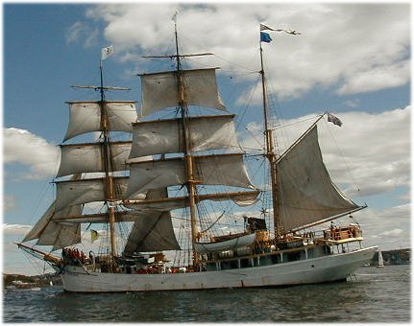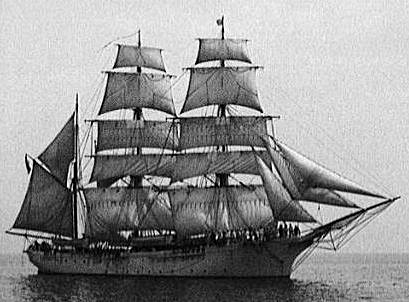

 |
|
Ayr, the county town of Ayrshire, Scotland, is situated on a fine bay with sandy beaches
at the mouth of the river Ayr, 41 miles south-south-west of Glasgow. From 1790 until 1806,
Robert Ralston and Robert Smith engaged in shipbuilding and timber trading on the north bank
of the river. During this time, the shipyard built three-masted barques for conducting
passengers to British America and returning with Canadian timber, two-masted brigs for
delivering coal to the west coasts of England and Scotland and the east coast of Ireland,
single-masted sloops for inshore fishing, and two-masted schooners for fishing and coastal trade.
In 1804, Ralston and Smith launched the three-masted barque, Margaret Bogle. She was 104 feet long from bow stem to stern post, 27 feet wide (beam), and 18 feet deep (draft). Her wooden hull displaced 324 tons of water. The fore and main masts carried square sails rigged athwart (across the deck). The mizzen mast was rigged with fore-and-aft sails. She was owned by John Smith, a Leith Merchant, and his two brothers, Walter and Thomas, who were both ship captains. In 1811 the British government nearly doubled the already high import duties on all timber brought in from the Baltic and other European ports. It became economically feasible to sail the Atlantic to Canada, to buy timber and bring it back to be sold at auction in Scotland. Emigration agents sold passenger fares on merchant vessels westbound for the United States and Canada. The profits were made on the timber. The passenger income helped to defray the operating expenses. Passenger accommodations were minimal at best. With the defeat of Napoleon at Waterloo in 1815, the war with France was over. The British economy began a rapid decline, and from 1830 on, Scotland was in a severe economic depression. Agricultural laborers began leaving the tenant farms and seeking employment in the urban areas. They did not have the skills necessary for factory work or for city living. Canals and other inland travel improvements offered increased mobility and many Scots fled to the seaports on both coasts and sailed to new homes in the United States and Canada. |
 |
|
The Margaret Bogle made several voyages to New York, Quebec and Montreal. One such voyage from Leith
in 1826 included a visit to Waterford, Ireland before proceeding to Quebec. The next year she sailed from
Leith to Halifax to New York and returned to Liverpool before sailing again to New York and then to Baltimore.
In 1833, the Margaret Bogle carried 68 passengers to Quebec and returned with Canadian timber.
The timber made a profit of £370 and the total
collected from the passengers was £180. The
average fare was £2. 10s. for passengers
supplying their own food. This cheap fare was possible because of the timber cargo on the return journey to
Scotland, and because passenger comforts were Spartan.
In order to establish risks to passengers and freight rates, ship owners were required to allow regular inspections and ratings of seaworthiness of their vessels. Lloyd’s of London surveyed the Margaret Bogle and rated her not A-1 (first class) but E-1 (second class), because of her age and quality of construction. Merchant vessels were chosen for their stowage capacity and maneuverability in heavy seas and not for passenger comfort. Nonetheless, laws existed requiring passenger loads to not exceed 3 passengers for every 4 tons (243 maximum for the Margaret Bogle), and the distance between decks to be not less than 5 feet 6 inches. Some immigration ports like Quebec levied a quarantine tax of 5 shillings for each overseas passenger to pay for the medical services required upon arrival. The Atlantic crossings were no picnic! Three-masted barques of up to 800 tons could be handled by crews of 14 to 16 men. This usually included a captain, first and second mate, carpenter, cook, half a dozen able seamen, a couple of ordinary seamen, and a deck boy or two. Barrels of salt pork, salt beef, fruits and vegetables, molasses, and fresh water, and sacks of bread, oatmeal, sugar and other provisions were loaded aboard to feed the passengers and crew during the eight-week journey. On 03 April 1835, James Ormiston boarded the Margaret Bogle, signed on as passenger to the United States, and listed his age on the ship’s manifest as 19. The passengers were accommodated between decks, “in steerage.” Temporary wooden planking had been placed over cross beams and carpenters had been called in to build temporary berths along the sides. Space was cramped and conditions were uncomfortable. The only means of ventilation was through the hatches, and in stormy seas, the hatches could be kept battened down for days.
|
 |
|
Of the three possible routes from Scotland to New York, the Margaret Bogle took the northern route.
She sailed first from Leith into the North Sea and west around the Orkney Islands and into the Atlantic.
Picking up the west Greenland current around the southernmost tip of Greenland, she sailed for Baffin Bay
to pick up the Labrador current coming south out of Davis Strait. Then, following the southern current
around Newfoundland and Nova Scotia, she sailed into New York harbor.
James celebrated his 20th birthday in the middle of the Atlantic Ocean. He was born on 08 May 1815. Under the command of ship master Walter Smith, 46 passengers reached the port of New York on 29 May 1835. Carpenters were again called upon to remove the temporary passenger berths and to prepare the decks to receive timber. The Margaret Bogle headed for Canada. Six years later, the Margaret Bogle received needed repairs. In 1841, her hull was sheathed in copper, and she got new hull top sides and other major repairs. In 1842 were added a new deck and other minor repairs. The Margaret Bogle returned to carrying passengers from Scotland to New York, Quebec and Montreal, and carrying Canadian timber on the eastward voyage home.
|
 |
|
In order to more fully appreciate seafaring life as it was in the mid-1800's, modern traveling families are
invited to travel to Mystic, Connecticut and see the Mystic Seaport Maritime Museum and reconstructed New England
village. For a preview, check out the Mystic Seaport website.
The centerpiece for this seafaring museum is the whaling vessel, Charles W. Morgan, built in 1841. With a deck of 105 feet, a beam of 27 feet, a draft of 18 feet and volume of 314 tons, the Charles W. Morgan, rigged as a three-masted barque, is a nearly exact match with the Margaret Bogle. Other Mystic attractions include a working shipyard restoring historic ships, a village of 30 New England trading shops, and opportunities to climb aboard a number of historic tall ships. Special events are planned for all ages and unplanned, self-guided tours are also available. Visit Mystic and experience the sights, the sounds, the smells, and the taste of seafaring as it was when the Ormistons sailed from Scotland to their new homes in America. |
|
|
Return to ORMISTON HOME page |
